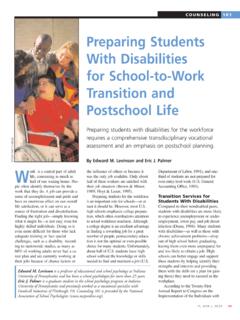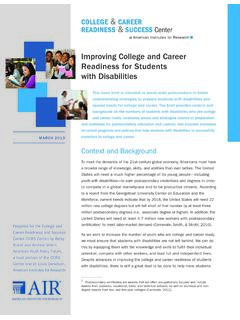Transcription of What Is Special About Special Education for Students with ...
1 140 THE JOURNAL OF Special Education VOL. 37/NO. 3/2003/PP. 140 147 How is Special Education for Students with learning disabili-ties Special ? One way to approach this question is to reviewthe intervention and descriptive studies of instruction and ser-vices for Students with learning disabilities (LD) and reportthe ways in which Special Education provides a differentiatedand appropriate Education for Students . At least with respectto the Education that Students with LD receive within generaleducation, existing reviews reveal that undifferentiated in-struction not specifically designed to meet the instructionalneeds of the student with LD prevails (see for review, Baker& Zigmond, 1995; McIntosh, Vaughn, Schumm, Haager, &Lee, 1993; Zigmond et al., 1995). Thus, there is a gap betweenwhat we know About effective instruction and the extent towhich these practices are carried over into instructional set-tings.
2 However, we were concerned that focusing on thiswould ignore aspects of Special Education that are associatedwith improved outcomes for Students with this article, we describe what was perceived in the not-so-distant past as necessary Special instruction for studentswith LD and the relatively recent view linking progress mon-itoring and instructional outcomes as markers for progresswith Students with LD. In order to address the question of whatis Special About Special Education for Students with LD, wefirst briefly review the literature About how Special educationwas initially conceptualized for these Students and how ef-fective instructional models for those Students have shiftedfrom using underlying process approaches to emphasizing in-structional effectiveness based on Students learning in coreacademic areas. We then describe a three-tiered model for pro-viding Special Education to Students with Is Special About Special Education for Students with Learning disabilities ?
3 Sharon Vaughn and Sylvia Linan-Thompson, The University of Texas at AustinIn this article, the ways in which Special Education for Students with learning disabilities was perceivedas Special historically and what we know About effective Special Education instructional practices forstudents with learning disabilities currently are summarized. The influence of monitoring progress,providing explicit and systematic instruction, understanding the critical factors associated with progressin academic areas such as reading and math, and teaching Students in small groups with many oppor-tunities to practice and obtain feedback are essential features of Special Education for Students withlearning disabilities . A model for providing integrated services between general and Special educationfor Students with learning disabilities is Education and Students with Learning DisabilitiesFor many Students with disabilities , the initial goal of specialeducation was to ensure that they were provided an opportu-nity to attend and profit from Education ; that is, that a free andappropriate public Education be provided to them, just like toall other youngsters.
4 This was the basis for the landmark leg-islation known as the Individuals with disabilities EducationAct (IDEA; reauthorized in 1997), which gave all studentswith disabilities the right to public Education . For studentswith LD, who were already provided Education within thegeneral Education system when IDEA was enacted (1977), Special needs would now be identified and specialized treat-ment would be parents, Students , and educators recognizedthat the educational needs of Students with LD were inade-quately met by general Education alone, little was knownabout what an effective educational program for Students withLD should look like. As a result, the Special Education of stu-dents with LD has traveled a somewhat rocky road of falsestarts, misconceptions, and misinformed ideas until 10 yearsago, when the progress in teaching these Students began toshow much promise (Kavale & Forness, 2000; Swanson, Hos-kyn, & Lee, 2000; Vaughn, Gersten, & Chard, 2000).
5 In this article, we review where we have been with treat-ments for Students with LD, discuss the extent to which thetreatments are Special , and describe a model for early pre-vention and intervention. Last, we present some of the criti-cal findings About teaching Students with LD that inform whatAddress: Sharon Vaughn, 42 Buckeye Trail, Austin, TX 78746; e-mail: Special About Special Education and how these techniquescan be effectively and Remediation of Underlying Process DisabilitiesThe hallmark of early instruction for Students with LD wasinstruction based on models of neurological and/or process-ing disorders in which identification and treatment of learn-ing problems were linked to the underlying processes thatinterfered with effective learning. Although it may be accu-rate that many Students with LD have underlying neurologi-cal and/or processing disorders, researchers and educatorshave been singularly unsuccessful at reliably identifying thesedifficulties and designing specific treatments to remediatethem (for a review, see Lyon, 1985; Mann, 1979).
6 It would be incomplete to examine early work in pro-viding educational treatment for Students with LD without re-viewing the work of Samuel Kirk. As early as 1962, Kirkpresented the notion of intraindividual differences to describewhat was Special About educating Students with LD. In Kirkand Kirk (1971), the idea was described as a concept thatdirects attention not to the comparison of one childwith another but to differences of ability within asingle child. In other words, the concept of intra-individual differences leads logically to psychomet-ric tests that could measure a number of specific anddiscrete areas of psychoeducational principal use is to diagnose a child s psycho-linguistic abilities so that remediation can follow.(pp. 11 12)Process s concept of intraindividualdifferences was the foundation of early work in LD. It was be-lieved that the psychoeducational strengths and weaknessesthat contributed to Students learning could be identified andan educational treatment plan that capitalized on Students strengths and remediated weaknesses could be defined.
7 Withthis course charted, many assessment and remediation prac-tices in LD were devised and implemented. Johnson andMyklebust (1967) also contributed significantly to early un-derstanding of treatment of such Students . They identified pro-cedures for first conducting an intensive diagnostic study andthen developing an individualized plan that was based on alanguage deficit such as the Illinois Test of PsycholinguisticAbility(ITPA; Kirk, McCarthy, & Kirk, 1968) were designedto determine Students strengths and weaknesses and to pre-scribe corresponding treatment. The ITPA, which was fre-quently used to diagnose processing problems, consists ofthree dimensions:1. Channels of communication include the modesof expression for receiving and expressing The psycholinguistic processes relate to the ac-quisition of The levels of organization refer to communica-tion habits, including more complex mediatedlearning (representational level) and less volun-tary learning (automatic level).
8 Student profiles can be generated based on the subtests thatcorresponded with each of these three dimensions of the tasks, activities, and instructional programs are spec-ified for instructing Students in the processes that correspondwith the tasks (Kirk & Kirk, 1971).The concern with process assessment and treatment hasbeen that underlying learning deficits and processes were notreliably identified and the corresponding treatments were notspecific to the learning problems. Although the efficacy ofpsycholinguistic training has been much debated, treatmentswere not in fact powerful enough to make discernable differ-ences in academic learning the most important outcome(Hammill & Larsen, 1974, 1978; Kavale, 1981; Larsen, Par-ker,& Hammill, 1982; Lund, Foster, & McCall-Perez, 1978).The emphasis on underlying mechanisms related to learningyielded undue focus directed to remediating process deficitsand too little focus on instructing Students in their target areasof need ( , reading, math).
9 Thus, process remediation as ameans to resolving LD went unsupported (Chall, 2000;Kavale, 1980; Kavale & Forness, 2000; Kavale & Mattson,1983; Silver, 2001). However, it is important to note that de-spite lack of support for process identification and treatmentmodels, they continue to persist. Thus, early in the field ofLD, unique treatment approaches for Students with specificLD, were devised yet were often not directly related to learn-ing goals; these approaches were implemented broadly andcontinue today in spite of little information on the fidelity ofimplementation and weak results related to learning is important to note that past failures in identifying andremediating processing problems do not necessarily forecastfuture failures. Three impediments have so far stood in Knowledge About the neurological under-pinnings of learning and LD has not been The measurement needed to identify specificprocess disorders in learning has not been precise enough (Keogh, 1994a; Lyon, 1994).
10 3. Matching the subtype of a learning problemwith appropriate treatments has not been carried out , future research may yield better scientific under-standing of these principles, and a return to process approachmay well serve individuals with LD. Thus, theoretically soundand empirically driven work that attempts to better informthese issues should be considered as feasible and desirableprogress in the JOURNAL OF Special Education VOL. 37/NO. 3/2003141142 THE JOURNAL OF Special Education VOL. 37/NO. 3/2003 Modality-Matched and Multisensory to sight, hearing, touch or movement. Thelearning modality approach to instruction is based on the as-sumption that learners have preferred modalities for learningand teaching that is redesigned to rely more directly on thispreferred modality will help Students learn more readily andrapidly. For teachers of Students with LD, the rationale is toidentify each student s preferred modality and to match teach-ing to this modality preference.


















